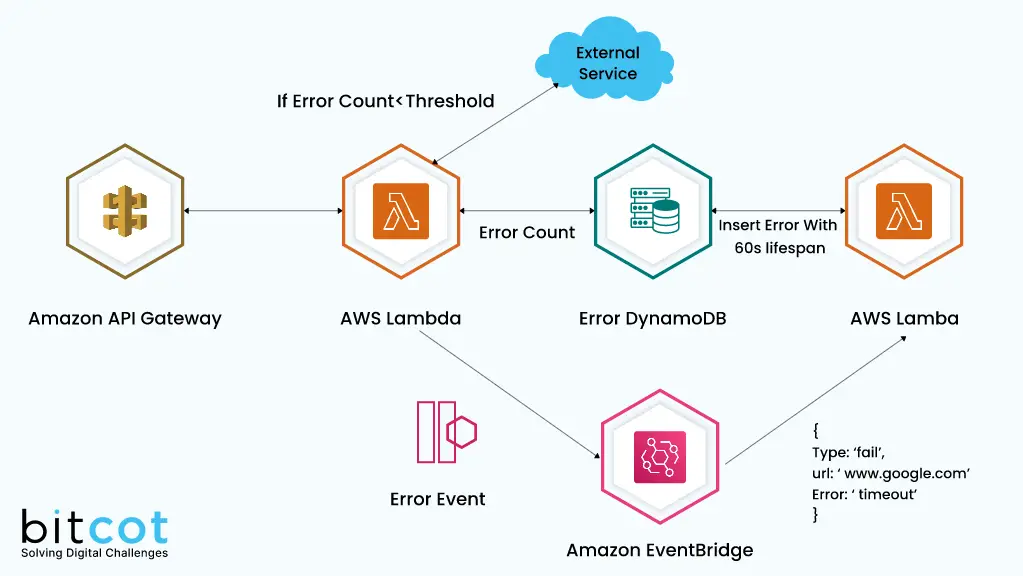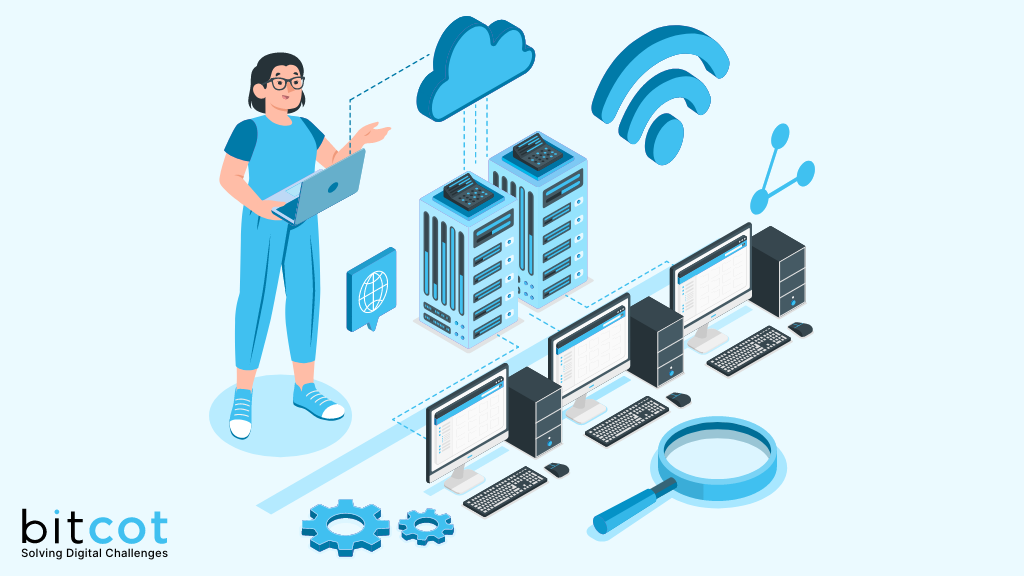
Amazon Web Services (AWS) provides a host of tools and services that have transformed the landscape of cloud computing. Among these, AWS IoT Core stands out as a game-changer for building IoT (Internet of Things) applications. This article delves into the workings of AWS IoT Core, providing a comprehensive understanding for both developers and business owners looking to leverage this powerful tool.
What is AWS IoT Core?
AWS IoT Core is a managed cloud platform that enables connected devices to easily and securely interact with cloud applications and other devices. It can support billions of devices and trillions of messages and can process and route those messages to AWS endpoints and other devices reliably and securely.
AWS IoT Core in Action: A Simplified Overview
AWS IoT Core is designed to support MQTT, a lightweight messaging protocol for small sensors and mobile devices. This protocol is optimized for high-latency or unreliable networks, making it a great fit for IoT applications.
Consider an example where a smart thermostat in your home is connected to AWS IoT Core. The thermostat sends temperature data using MQTT to AWS IoT Core, which securely transmits the data to a mobile app on your phone. You can also control the thermostat remotely using the app, with commands sent via AWS IoT Core.
Here’s a sequence diagram to help visualize this flow:
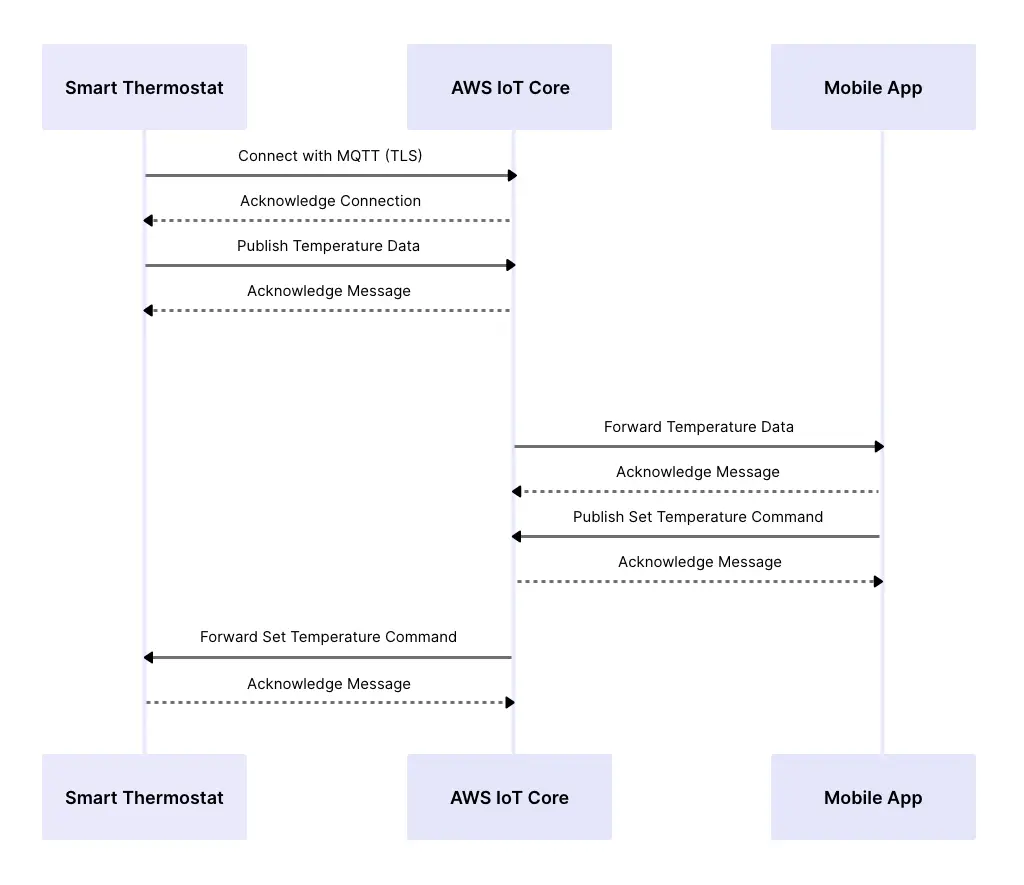
The Role of MQTT in AWS IoT Core
MQTT (Message Queuing Telemetry Transport) is a lightweight messaging protocol that is designed for constrained devices and low-bandwidth, high-latency, or unreliable networks. Its design principles make it an ideal choice for IoT applications and other situations where a small code footprint is required, and network bandwidth is at a premium.
In the context of AWS IoT Core, MQTT plays a vital role in enabling efficient, real-time, two-way communication between devices and the cloud. Devices can publish (send) messages on a specific ‘topic’, and other devices or applications can subscribe to these topics to receive the messages. This publish-subscribe model is the heart of MQTT and forms the basis of interaction in AWS IoT Core.
Here’s a sequence diagram showing an expanded view of MQTT communication in AWS IoT Core:
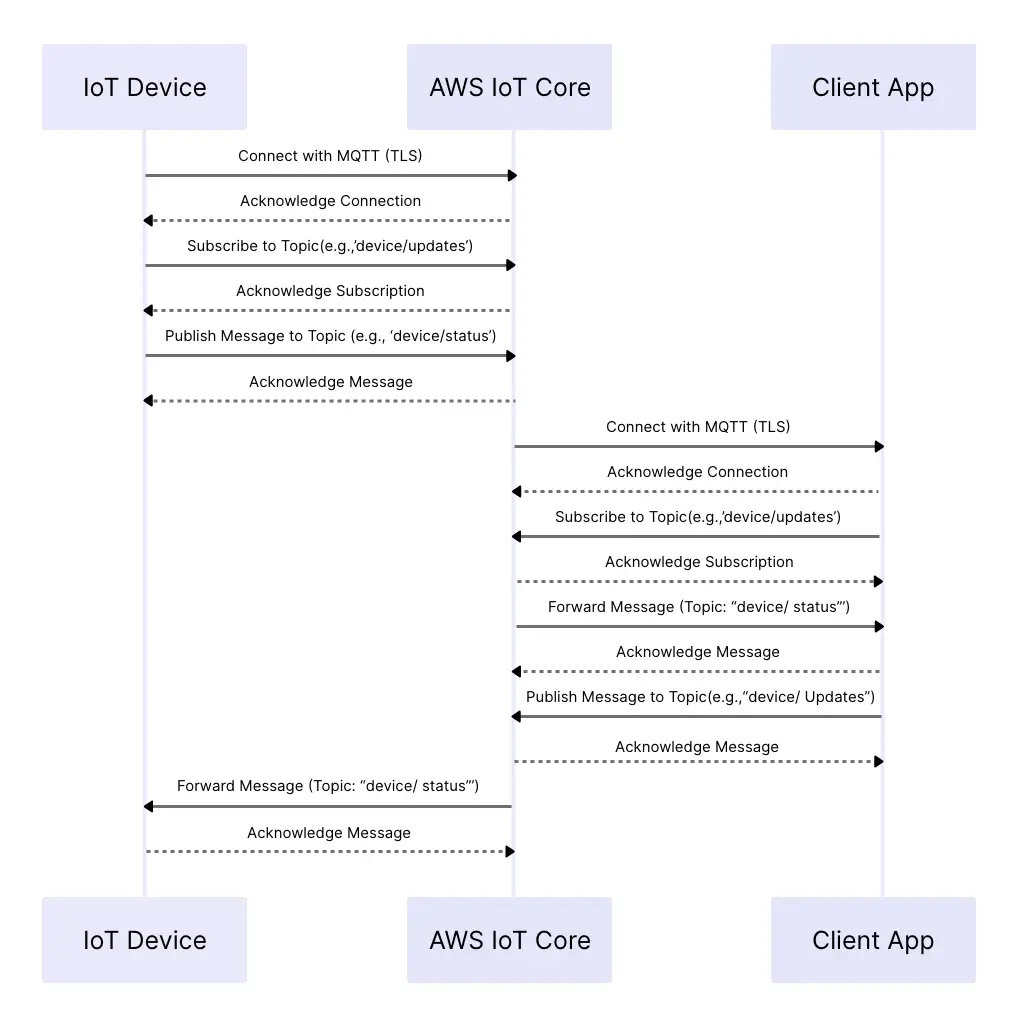
This diagram shows a typical interaction pattern between an IoT Device, AWS IoT Core, and a Client App using MQTT. The IoT Device and Client App are both publishing messages to topics and subscribing to topics, enabling two-way communication.
MQTT’s efficient publish-subscribe pattern, combined with its light-weight nature, makes it a critical component of AWS IoT Core, enabling seamless and efficient communication between billions of IoT devices and the cloud.
Security in AWS IoT Core
For IoT applications, establishing a secure connection between devices, AWS services, and applications is critical. AWS IoT Core provides robust security mechanisms including certificate-based mutual authentication, custom authorizers, and Amazon Cognito Identity.
Application Authentication via Amazon Cognito Identity Pools:
When using Amazon Cognito for application authentication, the process involves leveraging Cognito Identity Pools. Cognito Identity Pools are designed to provide AWS credentials to users so that they can access AWS services. In the context of AWS IoT, these credentials can be used to authenticate an application.
Here is a simplified step-by-step process:
- Create a Cognito Identity Pool: The first step involves creating a Cognito Identity Pool in the Amazon Cognito console. This pool will contain identities for users who will be using your application.
- Create an App Client: Once the identity pool is set up, you’ll need to create an app client. The app client is a component that interacts with the identity pool to create and manage user identities.
- Generate and Store AWS Credentials: When a user starts your application, the app client communicates with the Cognito Identity Pool to generate temporary, limited-privilege AWS credentials for that user. These credentials are then stored securely on the user’s device.
- Use AWS Credentials for Authentication: The application can then use these AWS credentials to sign requests to AWS IoT Core. When the application makes a request, AWS IoT Core can check the credentials to verify that they are valid and determine whether the request should be authorized.
By using Amazon Cognito Identity Pools, you can delegate the complex task of managing individual AWS credentials to Amazon Cognito. This allows you to focus on building your application, while Amazon Cognito takes care of the details of user authentication and secure credential management.
Please note that while this approach simplifies the process of user sign-up and sign-in, it’s important to understand that managing security for your IoT applications is a shared responsibility. You should always follow best practices for securing your application, such as encrypting sensitive data and limiting the permissions of your AWS credentials.
Configuring IoT Devices with AWS IoT Core
In this section, we will walk you through the steps to connect your IoT device with AWS IoT Core. This includes creating and activating a device certificate, attaching a policy to the certificate, and configuring the device with AWS IoT Core.
Step 1: Creating a Device in the AWS IoT Registry
The first step in connecting an IoT device to AWS IoT Core is creating a representation of that device in the AWS IoT registry. In the AWS IoT console, you can create a ‘Thing’ which represents your device. Each ‘Thing’ has a unique name and can have attributes and certificates associated with it.
Step 2: Creating and Activating a Device Certificate
Secure communication between your device and AWS IoT Core is accomplished through the use of X.509 certificates. In the AWS IoT console, you can create a certificate for your device. Once created, the certificate must be activated and then downloaded to your device.
Step 3: Attaching a Policy to the Certificate
A policy in AWS IoT Core specifies what actions a device can perform (like connecting, publishing, or subscribing to MQTT topics). You need to create a policy that allows the necessary actions and then attach this policy to your device’s certificate.
Step 4: Configuring the Device to Use the Certificate
Once the certificate is downloaded to your device, you will need to configure the device to use this certificate for its communication with AWS IoT Core. This usually involves updating the device’s configuration file with the path to the certificate and the private key, and also the endpoint for AWS IoT Core.
Step 5: Testing the Connection
After the device is configured, you should test the connection to AWS IoT Core. This can be done by having the device publish a message to an MQTT topic and seeing if that message appears in the AWS IoT console.
Remember, configuring IoT devices involves handling sensitive cryptographic material and should be done carefully. In production environments, measures should be taken to protect this material, such as using secure elements on the device or using AWS IoT Core’s Just-In-Time Registration (JITR) or Just-In-Time Provisioning (JITP) features.
By following these steps, you can securely connect your IoT device with AWS IoT Core and start leveraging the powerful features it provides for IoT applications.
The Role of Device Shadows in AWS IoT Core
Device Shadows are virtual, cloud-based representations of IoT devices. They store the latest state of a device, enabling applications to read data and interact with devices, even when they’re offline.
For instance, the mobile app from our earlier example can publish a desired temperature to the device shadow. The next time the thermostat connects to AWS IoT Core, it can sync with its device shadow and adjust its temperature accordingly. This concept allows for asynchronous interactions between devices and applications, enhancing the overall user experience.
Consider the following example of a device shadow for a smart thermostat:
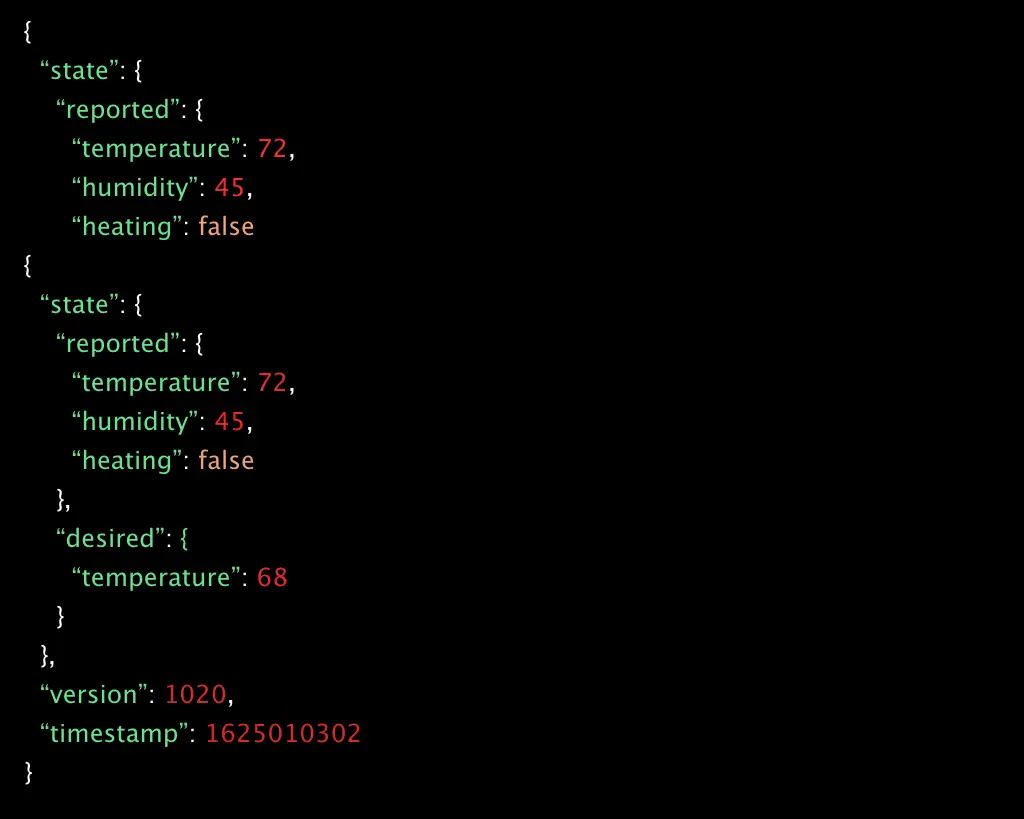
In this example, the ‘reported’ state represents the current state of the thermostat, while the ‘desired’ state represents the target state of the thermostat. When the thermostat connects to AWS IoT Core, it can read its ‘desired’ state from the device shadow and adjust its settings to match. Similarly, the thermostat can report its current state to the device shadow, which can be read by the mobile app.
Conclusion
As businesses and developers continue to explore the possibilities of IoT, platforms like AWS IoT Core provide the robust, secure, and scalable solutions needed to succeed in this exciting field. With its powerful features like MQTT support, robust security, and device shadows, AWS IoT Core can power a wide range of IoT applications, from smart homes to industrial automation.
As we move forward into 2023, we can expect to see even more exciting developments in AWS IoT, such as enhanced machine learning capabilities, improved edge computing support, and advanced analytics features. These advancements will provide even more tools for businesses to leverage IoT data, make more informed decisions, and deliver superior customer experiences.
Whether you’re a developer looking to dive into the world of IoT or a business owner seeking to leverage this technology for growth, AWS IoT Core offers a wealth of opportunities. So start exploring today, and see what you can build with AWS IoT Core!



